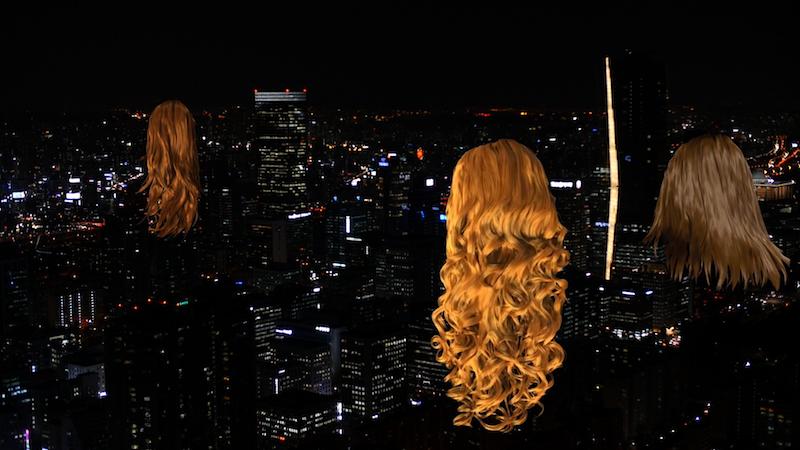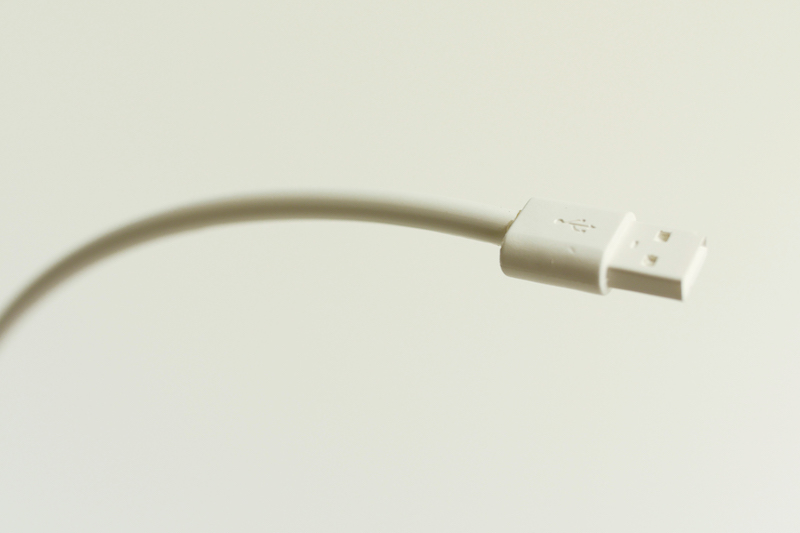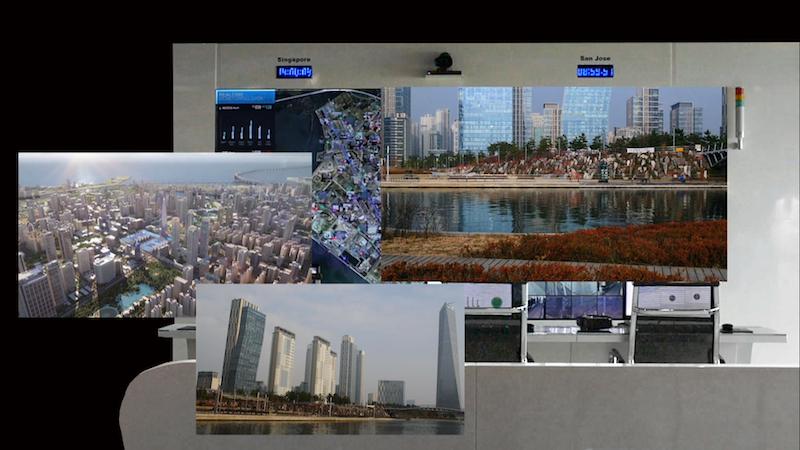
“To Make You Feel Comfortable” (Video still) © Julia Weißenberg
In her video “Nothing to Retain” from 2014, Julia Weißenberg investigated how much impact an architectural design from decades ago could have on the present. The site and the subject of the work is the architectural model of clubhouse for a golf club in Krefeld founded in the 1930s. The 1:1 scale model was built after 2013, to a hitherto unrealized design by Mies van der Rohe. Julia Weißenberg, who graduated from the Academy of Media Arts in Cologne in 2012, has been broadening her range of topics throughout the past 2 years, by moving from visionary architectures to the utopias of city planning.
Jürgen Dehm: In your latest works designs for planned cities from different parts of the world play are central role. What do you find so fascinating about urban planning?
Julia Weißenberg: The city or housing spaces we live in have a huge impact on us. And I think that different concepts of reality can be deduced from architecture and city planning. Due to the impact that city planning can have, I think it is essential to reflect upon the different approaches behind the architectures and to state a position on them. By way of their decisions city planners and architects can encourage certain behaviours of the inhabitants – for example how an urbanite moves through the city space or how the neighbourhood structures within big cities will develop.
JD: Already in his essay “The Metropolis and Mental Life”, published in 1903 the German sociologist, Georg Simmel describes the enormous psychological strain the individual is under when being bombarded by numerous stimuli and sensory impressions in rapid succession.
JW: Big cities are a complex framework and their sensory stimuli can constitute a challenge to the individual. But I do not perceive them as a strain per se. I think it largely depends on the structure of the city. Cities that have grown historically, and over a long course of time, differ significantly from the mega-cities like in China, because these cities have no grown compartmentalised structures. I believe the city offers a lot more possibilities for personal development than a small village, especially because it is anonymous. This means there is no social control. I regard especially the diversity of the city as very important. But on the other hand in many of those rapidly growing cities, there are problems like social isolation or air pollution, and this has a direct impact on the inhabitants’ quality of life. This is what the so-called smart cities are about. They should enable an efficient use of energy, an optimal utilisation of transportation networks, increased security and an improved handling of the complexity. These are digitally networked cities where everything from the flat to the motorway is connected to the so-called Internet of Things (IoT). This means that every appliance from the toaster to the light switch, from the heating to CCTV in public city spaces is continuously exchanging data. However, the continuous collection of data also enables the total surveillance of the residents
JD: In your video work “Imaginary City” you are connecting city designs with the geometric vocabulary of the mandala. How did this connection come about?
JW: Time played an essential role in this work. The formation of sand, which one needs for the production of concrete, is a very protracted process, and sand as a resource is not as quickly renewable as it is used by us. Architectural designs and utopias, as they are created in the 3-D visualisations, propagate precisely the opposite. Cities, Olympic stadiums etc. are build in a speed one can get dizzy by. The motives that I have used in this mandala are taken from designs for e.g. Qatar, Dubai or China. I wanted to approach the construction boom of these countries and the designs of urban utopias created in the 3-D visualisations with something that lasts – but also with the question of transience.




"USB Power" © Julia Weißenberg
JD: In addition to the video work you often create sculptural pieces. How do these relate to one another?
JW: In this case, I wanted to juxtapose the video that deals with the constant exchange of data within a smart city with something material, with an actual thing. I am generally interested in exploring diverse media within the context of the subject I am dealing with. I think these works can compliment one another but they can also exist by themselves and independent from one another.
JD: “USB Power” that belongs to “To Make You Feel Comfortable” appears in the shape of a belligerent snake…
JW: “USB Power” is the cast of a USB-cord and a portable power bank for a mobile phone, both made from synthetic resin. A USB-cord is a classic data cable. In connection with the Internet, social media and of course the smart cities the issue of data security has been much discussed for some time now. I think it is very interesting that the individual user data is not protected by copyright and that major corporations like Facebook or Google can use the data as they wish. We are all aware of that, but still, we handle our private information quite liberally. Their convenience is what makes these online services so seductive. However wireless is trending upwards – the cables are becoming extinct and the main proportion of data exchange runs via Wi-Fi. If one connects a cable to a computer to transfer data, it is a conscious act. To me, it implies that something is moving, e.g. from the external hard drive through the cable onto the computer. It is different from simply pressing a virtual button that says ‘download’ and the data moves, as if by magic, to another device.
JD: So the variety of artist residencies that led you to many different countries through the past months has been important in this regard?
JW: Spending 3 months in Seoul has certainly influenced me. It has pushed my involvement with the subject of the smart city forward because right at the gates of Seoul the planned city New Songdo is in the process of being built since 2003. This building process has already received a lot of international attention because it is a very early, very ambitious venture following the smart city concept. It has not been finished yet, but the city centre is complete and some people are already living and working there. I have visited the place several times and was able to do on-site research and to be affected by this very artificial space…

“To Make You Feel Comfortable” (Video still) © Julia Weißenberg
JD: How would you describe your artistic practice?
JW: It usually starts with a certain aspect that grabs me. This can be a real event or simply an image. Mostly this is about a certain fascination or about something that confuses me and attracts my attention. Some topics keep reoccurring, as for example architecture and space play an important role in my practice, or the question of the real versus the fictional.
JD: Do you do extensive research?
JW: In most instances, I do a lot of research in the beginning. I have documents in which I note everything of significance or compile links to images. On a deeper level, texts from Jean Baudrillard, Heinz von Foerster, Richard Sennett or Lars Spuybroek play a role. For some time, I have been concentrating on neuroscience. I am no theoretician and I do not work in a conceptual manner, but I am convinced that information that makes an impression on me finds its way into my work – also indirectly. The form of my work eventually depends very much on its subject. What I find exciting about video is that one is working with images, hence remains in the same medium, but one has still numerous additional possibilities such as how the pictures are assembled or which aesthetic one chooses. I am interested in trying things, in understanding how and why they work.
JD: Is your relationship with the digital consistently positive?
JW: I have a few concerns and also big reservations regarding the digital world. I have only owned a smart phone for a year now – perhaps this shows my scepticism. Still, it would be certainly too easy to simply surrender to cultural pessimism and condemn all of it. But this is not my way of looking at things. We are part of this digital world by now and we have to find a sound way of dealing with it. It is essential that our data is protected and cannot be utilised by corporate interests, or constitute the basis for manipulating humans. Here the governments are challenged. I think many things are bound to change drastically and even certain thought categories will be transformed. Such a process always incorporates resistance. But there are also many advantages. We are dealing with vast complexities and it is not easy to develop a position on them. Hence I do appreciate that the term “post-factual” is currently being talked about so frequently. So these topics are also discussed in popular media.
 "To make you feel comfortable", 2016 © Julia Weißenberg
"To make you feel comfortable", 2016 © Julia Weißenberg
Installation View, Stranger Days, Galerie Lisa Kandlhofer, Vienna, Austria, 2017
JD: How do you perceive the stream of images on the Internet in regard to the narration of a story, the narrative within a video for instance?
JW: The way one navigates through the Internet, and is taking in content, differs very much from how one reads a book for example. Whereas the time levels of books and videos are comparable, however with the difference that in a video I can stack many levels simultaneously, over one another, similar to switching between five open browser windows. In my recent video works I was interested in precisely that: fragmenting and interrupting the narration without dissolving it entirely. Eventually, this created an impression that consists of fragments, hence a connected, continuously structured impression. I believe that this very much reflects my experience when conducting Internet research. I have to force myself to focus in order to gain an in-depth overview of a topic, and the countless images that I come across I perceive mostly as some kind of white noise. Within this mass of images, one can quickly detect certain qualities, structures and strategies that cause an image to stand out. I think this could probably minimize the diversity in the long run, as calm images that do not “scream” will drown faster. But fortunately, there are other spaces where images can be viewed.
JD: How did your degree course at the Academy of Media Arts in Cologne prepare you for dealing with digital images?
JW: Before I started studying at the Academy of Media Arts in Cologne, I already studied communication design with an emphasis on photography for two years, and previous to that I worked as an assistant for a commercial photographer, who shot ad campaigns and record covers. I think this had a definite impact on me and influenced my decision to study fine art at the Academy of Media Arts in Cologne. There is an active critical involvement with digital images at their fine art department. Towards the end of my course, I studied with Mathias Müller. I have learned a lot about images from his way of reflecting film and video. But I graduated four years ago and obtain inspiration also from other artists and filmmakers and their strategies for dealing with video now.
STRANGER DAYS
Malte Bruns, Benedikt Hipp, Lindsay Lawson, Pascual Sisto, Julia Weißenberg
Curated by Jürgen Dehm
16.02. – 19.03.2017
Galerie Lisa Kandlhofer
Brucknerstrasse 4
1040, Vienna
Austria
Opening Hours: Tue – Fri, 11-19h,
Sat, 11h - 16h
